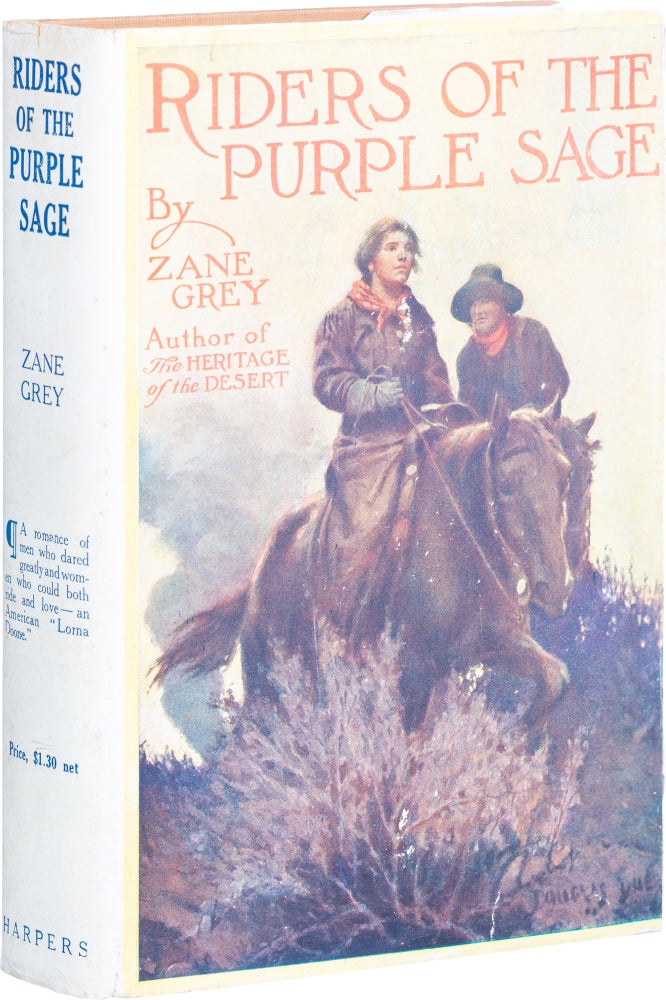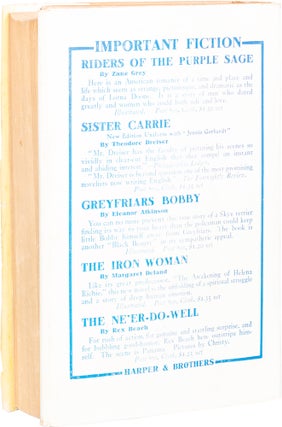Riders of the Purple Sage
New York: Harpers, 1912. First Edition. Hardcover. 1st edition of the preeminent early Western novel and the most popular one of all time. 1st printing with “MCMXII” on the title page, and 3 lines of copyright (the last line “published January, 1912”). Near fine in the enigmatically rare 1st printing dustjacket (red lettering on the front, blue on the spine and back, the spine priced $1.30, 5 titles on the back, and flaps with Harper boilerplate), back panel with a crease, front flap fold with a partial tear secured with 1 tiny speck of tape, and a few short edge tears, else near fine. Fine half morocco case. Near fine / near fine. Item #336
Almost all 1912 dustjackets are rare but this one is notoriously so, as rare as any major 20th century 1st edition in jacket. It’s just the 2nd copy I’ve seen, and the finest one I’ve ever heard about. Only 1 authentic copy in a correct jacket has sold at auction in the last 50 years, a chipped, worn, stained, and, repaired jacket, 25 years ago at Sotheby’s (the only other sale in the auction records was in a reprint jacket miscataloged by PBA). Under his penname of Ned Buntline, Edward Judson would, for a short time in the 19th century, become America’s most popular and wealthiest writer of fiction. When he met Buffalo Bill he shifted from sensational newspaper and magazine stories generally, to focusing his pen on Westerns, often published as Dime Novels, and established tales of the West as a genre. In 1902, Owen Wister wrote The Virginian and invented many of the now standard clichés, but it was Riders of the Purple Sage that was the first long novel with archetypal aspects, and a twisting, complex plot that developed along many lines. In it Grey perfected the modern Western, featuring the original, fastest gun Western hero (a laconic and soft–spoken loner, dressed in black, with an ingrained respect for women and a quick enthusiasm for using his guns to allot his own views of justice). Its impact on filmmaking was immediate and immeasurable. It was arguably, cinema’s most influential novel, and its copious themes of morality, redemption, revenge, honor, xenophobia, isolation, social pressure, religious confrontation, and the victimization of women, shaped, and echo in, all its descendants from The Ox–Bow Incident (1940), to Shane (1949), to True Grit (1968), to Blood Meridian (1984). And though it spawned a type, it had no precedent, or if one scratches the past with enough vigor and insistence, maybe James Fenimore Cooper, but the gap between them (75 years) makes the connection seem hollow. So, Riders of the Purple Sage was an outlier, first embraced by Hollywood, who didn’t have to bother improving it while making 1,000 movies, and then by literature, where it took the passage of a generation to do so. Here’s a peek into the future. The critics dismiss genre novels as escapist, and yet, that’s the aim of novels. Today the antiquarian book market seems to disparage Westerns beyond any other genre (fantasy, detective, horror, noir, adventure, mystery, beast–fables, and science–fiction) except romance. Will this change? It will. I can’t say when, but when it does, Riders of the Purple Sage will be as passionately sought as any of the most valuable 1st editions in any of the other genera.
Price:
$35,000.00


